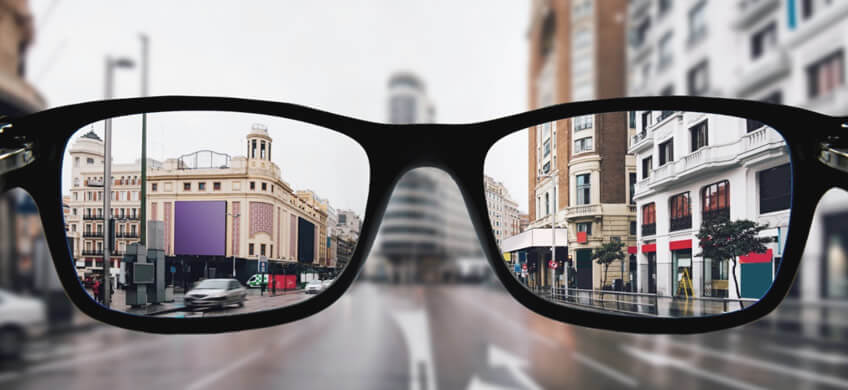
In driving, visual acuity is a basic requirement when obtaining or renewing your license. In fact, in Spain, for either of these processes, you must pass a medical examination that also includes an eye exam. It seems logical since if you can’t see properly, you would be endangering both your life and the lives of other drivers.
We’d say that, for the purposes of driving a vehicle, visual capacity refers to a person’s physical fitness that is essential for driving. In turn, traffic regulations establish several related parameters that are used to measure this capacity. They are primarily visual acuity, visual field and contrast sensitivity.
This is your eyes’ ability to discriminate between letters or other objects in certain lighting conditions. In other words, if you don’t have sufficient visual acuity, images will appear blurred and less clear.
It is measured on a general scale that goes from 0 to 1. This last number marks normal vision, while 0 indicates total lack of vision. In order for you to drive, traffic regulations require a minimum of at least 0.5 binocular vision (with both eyes at the same time). However, if you’re a professional driver, you will have to reach 0.8.
On the other hand, the visual field is the space the eye perceives when looking straight ahead without making any movements. You’ll notice that the centre of your visual field is where you’ll find the greatest sharpness and resolution, while at the ends it becomes more blurred. However, this does not prevent you from differentiating between objects, lights or movements. This is normal in a healthy eye.
Precisely, an eye that sees well has a visual field of approximately 91.5º temporally (outwards), 64º nasally, 55º upwards and 75º downwards. However, this range depends on factors such as lighting, colours and contrast. In addition, it can vary from one person to another.
The main alterations to your field of vision may be scotomas (you can’t see in one area), deformations and concentric visual field losses (you lose vision from the ends towards the centre). But there is also aphakia and pseudophakia (the absence of the lens or having an artificial lens). And then there’s palpebral and eyeball motility (inability to raise the eyelid or close it completely) and the progressive deterioration of visual capacity. And each of these problems will lead to a number of limitations when driving.
This is the third parameter that will be assessed when analysing your visual capacity. It’s defined as the eye’s ability to identify an object and clearly distinguish it from the background. The more difference there is between the two, the more intense your sensitivity will be. That is, it will be easier for you to differentiate a black object on a white background than if the background were also black.
On the other hand, even if you have good visual acuity, you won’t necessarily have good contrast sensitivity. These are two different things and, in order to assess your sensitivity, wave gratings are used with different frequency levels and contrasts, as well as contrast letters.
This sensitivity affects, for example, the glare caused by lights. In this regard, the Directorate General of Traffic requires that there be no alterations in your glare recovery. And you also can’t have problems related to mesopic vision. The latter is your ability to see in low-light conditions (for example, when it gets dark) or lighting from street lamps.
As we said, traffic regulations impose a series of restrictions on drivers if they have problems related to their visual capacity. These limitations depend on each of the parameters we have just presented.
In regards to this condition, if you are a normal driver, you should have a binocular vision (with both eyes) of 0.5. However, if you’re a professional, this figure rises to 0.8. In addition, if you are in the first group, the eye that sees the worst much reach at least 0.1. On the other hand, if you’re in the second group, the worst eye must reach at least 0.5.
As for the visual field, this limitation will depend on the problem your eyes have. Your eyes can’t have any significant scotomas. In addition, if you have ever been operated on for any type of aphakia, you will not be able to driver for a certain period of time.
On the other hand, traffic regulations will prohibit you from driving if you suffer from severe palpebral motility that prevents you from driving safely. Similarly, if you suffer from diplopia (double vision), you will not be able to get a driving license. If you already have a license and you get this condition, you will have to stop driving for at least 6 months.
Finally, the progressive deterioration of your visual capacity will also prevent you from driving at the point in time in which this deterioration becomes significant. This deterioration can be caused by diseases such as cataracts, glaucoma, retinitis pigmentosa or macular degeneration. Likewise, if you suffer from a retinal detachment and get surgery, you will have to wait 6 months in order to get your driving license back. To do so, you will also have to submit a medical specialist’s report.
Regarding contrast sensitivity, as we’ve already said, traffic regulations also establish limitations. It specifically states that you cannot drive if you suffer from considerable alterations in your glare recovery ability. Or if you have problems with your mesopic vision. That is, if you can’t see well in low-light conditions. For example, in the evening or at nighttime when the streets are lit up by street lamps.
In conclusion, visual acuity is a basic element for both your safety and that of other drivers. Therefore, in order to get or renew your driving license, you must have good vision. And we’re not just talking about your sight, but also your visual field and the contrast sensitivity of your eyes.